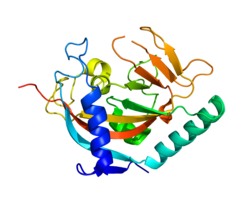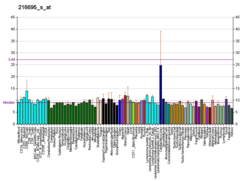Tankyrase
Tankyrase, also known as tankyrase 1, is an enzyme that in humans is encoded by the TNKS gene.[5][6][7] It inhibits the binding of TERF1 to telomeric DNA.[8] Tankyrase attracts substantial interest in cancer research through its interaction with AXIN1 and AXIN2, which are negative regulators of pro-oncogenic β-catenin signaling. Importantly, activity in the β-catenin destruction complex can be increased by tankyrase inhibitors and thus such inhibitors are a potential therapeutic option to reduce the growth of β-catenin-dependent cancers.[9]
Description[10]
Tankyrase-1 is a poly-ADP-ribosyltransferase involved in various processes such as Wnt signaling pathway, telomere length and vesicle trafficking. Acts as an activator of the Wnt signaling pathway by mediating poly-ADP-ribosylation (PARylation) of AXIN1 and AXIN2, 2 key components of the beta-catenin destruction complex: poly-ADP-ribosylated target proteins are recognized by RNF146, which mediates their ubiquitination and subsequent degradation. Also mediates PARsylation of BLZF1 and CASC3, followed by recruitment of RNF146 and subsequent ubiquitination. Mediates PARsylation of TERF1, thereby contributing to the regulation of telomere length. Involved in centrosome maturation during prometaphase by mediating PARsylation of HEPACAM2/MIKI. May also regulate vesicle trafficking and modulate the subcellular distribution of SLC2A4/GLUT4-vesicles. May be involved in spindle pole assembly through PARsylation of NUMA1. Stimulates 26S proteasome activity.[11]
Protein interactions
TNKS has been shown to interact with:
References
- ^ a b c ENSG00000285372 GRCh38: Ensembl release 89: ENSG00000173273, ENSG00000285372 – Ensembl, May 2017
- ^ a b c GRCm38: Ensembl release 89: ENSMUSG00000031529 – Ensembl, May 2017
- ^ "Human PubMed Reference:". National Center for Biotechnology Information, U.S. National Library of Medicine.
- ^ "Mouse PubMed Reference:". National Center for Biotechnology Information, U.S. National Library of Medicine.
- ^ a b Smith S, Giriat I, Schmitt A, de Lange T (Dec 1998). "Tankyrase, a poly(ADP-ribose) polymerase at human telomeres". Science. 282 (5393): 1484–7. CiteSeerX 10.1.1.466.9024. doi:10.1126/science.282.5393.1484. PMID 9822378.
- ^ Zhu L, Smith S, de Lange T, Seldin MF (May 1999). "Chromosomal mapping of the tankyrase gene in human and mouse". Genomics. 57 (2): 320–1. doi:10.1006/geno.1999.5771. PMID 10198177.
- ^ "Entrez Gene: TNKS tankyrase, TRF1-interacting ankyrin-related ADP-ribose polymerase".
- ^ Cook, B. D.; Dynek, J. N.; Chang, W.; Shostak, G.; Smith, S. (1 January 2002). "Role for the Related Poly(ADP-Ribose) Polymerases Tankyrase 1 and 2 at Human Telomeres". Molecular and Cellular Biology. 22 (1): 332–342. doi:10.1128/MCB.22.1.332-342.2002. PMC 134233. PMID 11739745.
- ^ Wang W, Liu P, Lavrijsen M, Li S, Zhang R, Li S, van de Geer WS, van de Werken HJ, Peppelenbosch MP, Smits R (April 2021). "Evaluation of AXIN1 and AXIN2 as targets of tankyrase inhibition in hepatocellular carcinoma cell lines". Scientific Reports. 11 (1): 7470. Bibcode:2021NatSR..11.7470W. doi:10.1038/s41598-021-87091-4. PMC 8018973. PMID 33811251.
- ^ "TNKS - Poly [ADP-ribose] polymerase tankyrase-1 - Homo sapiens (Human) - TNKS gene & protein".
- ^ Voges D, Zwickl P, Baumeister W (1999). "The 26S proteasome: a molecular machine designed for controlled proteolysis". Annu. Rev. Biochem. 68: 1015–68. doi:10.1146/annurev.biochem.68.1.1015. PMID 10872471.
- ^ Fuchs U, Rehkamp GF, Slany R, Follo M, Borkhardt A (Nov 2003). "The formin-binding protein 17, FBP17, binds via a TNKS binding motif to tankyrase, a protein involved in telomere maintenance". FEBS Lett. 554 (1–2): 10–6. doi:10.1016/s0014-5793(03)01063-9. PMID 14596906. S2CID 19552309.
- ^ Bae J, Donigian JR, Hsueh AJ (Feb 2003). "Tankyrase 1 interacts with Mcl-1 proteins and inhibits their regulation of apoptosis". J. Biol. Chem. 278 (7): 5195–204. doi:10.1074/jbc.M201988200. PMID 12475993.
- ^ a b Seimiya H, Smith S (Apr 2002). "The telomeric poly(ADP-ribose) polymerase, tankyrase 1, contains multiple binding sites for telomeric repeat binding factor 1 (TRF1) and a novel acceptor, 182-kDa tankyrase-binding protein (TAB182)". J. Biol. Chem. 277 (16): 14116–26. doi:10.1074/jbc.M112266200. PMID 11854288.
- ^ a b Sbodio JI, Chi NW (Aug 2002). "Identification of a tankyrase-binding motif shared by IRAP, TAB182, and human TRF1 but not mouse TRF1. NuMA contains this RXXPDG motif and is a novel tankyrase partner". J. Biol. Chem. 277 (35): 31887–92. doi:10.1074/jbc.M203916200. PMID 12080061.
- ^ Cook BD, Dynek JN, Chang W, Shostak G, Smith S (Jan 2002). "Role for the related poly(ADP-Ribose) polymerases tankyrase 1 and 2 at human telomeres". Mol. Cell. Biol. 22 (1): 332–42. doi:10.1128/mcb.22.1.332-342.2002. PMC 134233. PMID 11739745.
- ^ Sbodio JI, Lodish HF, Chi NW (Feb 2002). "Tankyrase-2 oligomerizes with tankyrase-1 and binds to both TRF1 (telomere-repeat-binding factor 1) and IRAP (insulin-responsive aminopeptidase)". Biochem. J. 361 (Pt 3): 451–9. doi:10.1042/0264-6021:3610451. PMC 1222327. PMID 11802774.
Further reading
- Andersson B, Wentland MA, Ricafrente JY, Liu W, Gibbs RA (1996). "A "double adaptor" method for improved shotgun library construction". Anal. Biochem. 236 (1): 107–13. doi:10.1006/abio.1996.0138. PMID 8619474.
- Yu W, Andersson B, Worley KC, Muzny DM, Ding Y, Liu W, Ricafrente JY, Wentland MA, Lennon G, Gibbs RA (1997). "Large-scale concatenation cDNA sequencing". Genome Res. 7 (4): 353–8. doi:10.1101/gr.7.4.353. PMC 139146. PMID 9110174.
- Smith S, de Lange T (1999). "Cell cycle dependent localization of the telomeric PARP, tankyrase, to nuclear pore complexes and centrosomes". J. Cell Sci. 112 (21): 3649–56. doi:10.1242/jcs.112.21.3649. PMID 10523501.
- Chi NW, Lodish HF (2001). "Tankyrase is a golgi-associated mitogen-activated protein kinase substrate that interacts with IRAP in GLUT4 vesicles". J. Biol. Chem. 275 (49): 38437–44. doi:10.1074/jbc.M007635200. PMID 10988299.
- Lyons RJ, Deane R, Lynch DK, Ye ZS, Sanderson GM, Eyre HJ, Sutherland GR, Daly RJ (2001). "Identification of a novel human tankyrase through its interaction with the adaptor protein Grb14". J. Biol. Chem. 276 (20): 17172–80. doi:10.1074/jbc.M009756200. PMID 11278563.
- Kim BY, Krämer H, Yamamoto A, Kominami E, Kohsaka S, Akazawa C (2001). "Molecular characterization of mammalian homologues of class C Vps proteins that interact with syntaxin-7". J. Biol. Chem. 276 (31): 29393–402. doi:10.1074/jbc.M101778200. PMID 11382755.
- Cook BD, Dynek JN, Chang W, Shostak G, Smith S (2002). "Role for the related poly(ADP-Ribose) polymerases tankyrase 1 and 2 at human telomeres". Mol. Cell. Biol. 22 (1): 332–42. doi:10.1128/MCB.22.1.332-342.2002. PMC 134233. PMID 11739745.
- Sbodio JI, Lodish HF, Chi NW (2002). "Tankyrase-2 oligomerizes with tankyrase-1 and binds to both TRF1 (telomere-repeat-binding factor 1) and IRAP (insulin-responsive aminopeptidase)". Biochem. J. 361 (Pt 3): 451–9. doi:10.1042/0264-6021:3610451. PMC 1222327. PMID 11802774.
- Seimiya H, Smith S (2002). "The telomeric poly(ADP-ribose) polymerase, tankyrase 1, contains multiple binding sites for telomeric repeat binding factor 1 (TRF1) and a novel acceptor, 182-kDa tankyrase-binding protein (TAB182)". J. Biol. Chem. 277 (16): 14116–26. doi:10.1074/jbc.M112266200. PMID 11854288.
- Sbodio JI, Chi NW (2002). "Identification of a tankyrase-binding motif shared by IRAP, TAB182, and human TRF1 but not mouse TRF1. NuMA contains this RXXPDG motif and is a novel tankyrase partner". J. Biol. Chem. 277 (35): 31887–92. doi:10.1074/jbc.M203916200. PMID 12080061.
- Rippmann JF, Damm K, Schnapp A (2002). "Functional characterization of the poly(ADP-ribose) polymerase activity of tankyrase 1, a potential regulator of telomere length". J. Mol. Biol. 323 (2): 217–24. doi:10.1016/S0022-2836(02)00946-4. PMID 12381316.
- Bae J, Donigian JR, Hsueh AJ (2003). "Tankyrase 1 interacts with Mcl-1 proteins and inhibits their regulation of apoptosis". J. Biol. Chem. 278 (7): 5195–204. doi:10.1074/jbc.M201988200. PMID 12475993.
- Loayza D, De Lange T (2003). "POT1 as a terminal transducer of TRF1 telomere length control". Nature. 423 (6943): 1013–8. Bibcode:2003Natur.423.1013L. doi:10.1038/nature01688. PMID 12768206. S2CID 4370276.
- Fuchs U, Rehkamp GF, Slany R, Follo M, Borkhardt A (2003). "The formin-binding protein 17, FBP17, binds via a TNKS binding motif to tankyrase, a protein involved in telomere maintenance". FEBS Lett. 554 (1–2): 10–6. doi:10.1016/S0014-5793(03)01063-9. PMID 14596906. S2CID 19552309.
- Seimiya H, Muramatsu Y, Smith S, Tsuruo T (2004). "Functional subdomain in the ankyrin domain of tankyrase 1 required for poly(ADP-ribosyl)ation of TRF1 and telomere elongation". Mol. Cell. Biol. 24 (5): 1944–55. doi:10.1128/MCB.24.5.1944-1955.2004. PMC 350561. PMID 14966275.
- Dynek JN, Smith S (2004). "Resolution of sister telomere association is required for progression through mitosis". Science. 304 (5667): 97–100. Bibcode:2004Sci...304...97D. doi:10.1126/science.1094754. PMID 15064417. S2CID 38793700.
- Ye JZ, de Lange T (2004). "TIN2 is a tankyrase 1 PARP modulator in the TRF1 telomere length control complex". Nat. Genet. 36 (6): 618–23. doi:10.1038/ng1360. PMID 15133513.







